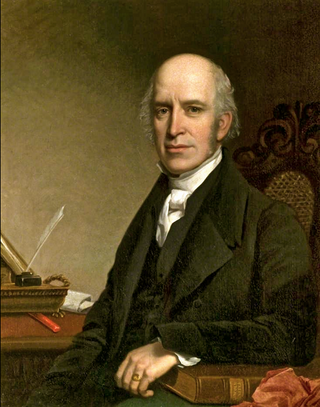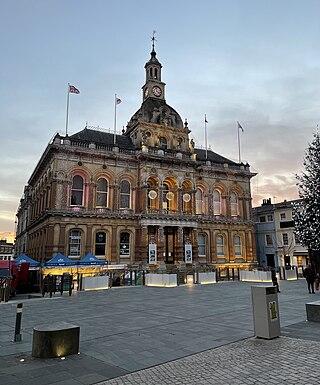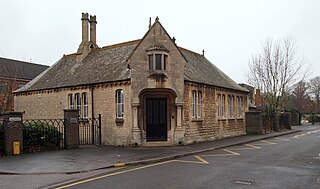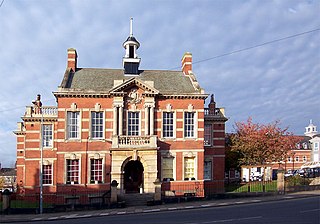
Boston is a market town and inland port in the borough of the same name in the county of Lincolnshire, England.

Sir George Gilbert Scott, largely known as Sir Gilbert Scott, was a prolific English Gothic Revival architect, chiefly associated with the design, building and renovation of churches and cathedrals, although he started his career as a leading designer of workhouses. Over 800 buildings were designed or altered by him.
Sir Frederick Ernest Gibberd CBE was an English architect, town planner and landscape designer. He is particularly known for his work in Harlow, Essex, and for the BISF house, a design for a prefabricated council house that was widely adopted in post-war Britain.

Sir Reginald Theodore Blomfield was a prolific British architect, garden designer and author of the Victorian and Edwardian period.

Stephen Lewin was an English architect, artist, civil engineer and iron-founder, who was a builder of steamboats and steam locomotives. Initially he worked in Boston in Lincolnshire as a civil engineer with his father William Lewin, who was an assistant to John Rennie the Elder. His should not be confused with his son, Stephen Samuel Lewin, a successful artist who specialised in historical works often featuring cavaliers and figures in 17th-century costumes.

Albert Edward Lambert FRIBA was an architect based in Nottingham, England.

John Tarring FRIBA (1806–1875) was an English Victorian ecclesiastical architect active in the mid-nineteenth century. Based in London, he designed many Gothic Revival churches for Nonconformist clients.

Edward James Willson was an English architect, antiquary, architectural writer, and mayor of Lincoln in 1851–2.

William Adams Nicholson (1803–1853) was an English architect who worked in Lincoln and was a founding member of the Royal Institute of British Architects.

Charles Bell FRIBA (1846–99) was a British architect who designed buildings in the United Kingdom, including over 60 Wesleyan Methodist chapels.

William Watkins (1834–1926) was an architect who worked in Lincoln, England, and is particularly noted for his Terracotta Revival Architecture.

Michael Drury was an English architect working in Lincoln.

Henry Goddard was an English architect who was a member of a family of architects who worked in Leicester. He moved to Lincoln and was later in partnership with his son Francis Henry Goddard.

Bellamy and Hardy was an architectural practice in Lincoln, England, that specialised particularly in the design of public buildings and non-conformist chapels. Pearson Bellamy had established his own architectural practice by 1845 and he entered into a partnership with James Spence Hardy in June 1853. Both partners had previously worked for the Lincoln architect William Adams Nicholson. Hardy was described as "Chief Clerk" to Nicholson. Hardy joined Pearson Bellamy immediately after the sudden death of Nicholson. As all known architectural drawings by the practice are signed Pearson Bellamy, it is likely that Bellamy was the architect and Hardy was the administrator in the practice. The partnership lasted until 1887. Bellamy continued to practise until 1896.

Kirk and Parry were an architectural and civil engineering practice in Sleaford that specialised in the design of public buildings, housing and the construction of Railways. The practice was initially founded by Charles Kirk (senior) (1791–1847). Thomas Parry, (1818-1879) was an articled clerk to Charles Kirk. Parry married Henrietta, daughter of Charles Kirk in 1841 and formed a partnership with Charles Kirk. Following the death of Charles Kirk in 1847, his son, Charles Kirk (junior) (1825-1902), then became a partner with Thomas Parry. Charles Kirk Junior was the architect in the practice and Parry probably acted as an administrator. Thomas Parry was a Liberal Party politician from who sat in the House of Commons for three short periods between 1865 and 1874. By 1903 the firm had changed its name to Kirk, Knight and Co. This article surveys the work of Kirk and Parry and its successor firm, from 1847 until it ceased trading in 1906.

Herbert C Scaping (1866-1934) was an architect who worked in Grimsby, Lincolnshire in the Arts and Crafts and Art Nouveau styles. He was born in Rathfarnham, co Dublin before his family moved to Hull, his only known family are his two daughters Rathlea and Rathgowry. He trained with Smith and Broderick of Hull, setting up his own practice in Grimsby in 1890. He became the Lincoln Diocesan surveyor and surveyor to Lord Heneage. Architect to the Grimsby Education Committee and Board of Guardians. His office was at Court Chambers in Grimsby.

Edward Browning was an English architect working in Stamford.

Eyre and Southall were an architectural practice with offices in Retford in Nottinghamshire and Gainsborough. William Southall (1868-1936) and William Eyre were working in the period from the late 1890s to the mid-1930s. Their offices were at 20 Chapelgate, Retford and at Trinity Street in Gainsborough. William Southall had previously worked as an architectural assistant in Marnchester and Dorchester before joining William Eyre. Southall qualified as LRIBA in 1910. William Eyre was also the Gainsborough Borough architect. Their work includes public buildings and housing in the Retford area and in the adjacent area of Lincolnshire. A collection of architectural plans by the practice are in the collection of the Bassetlaw Museum.

James Whitton was an architect and surveyor who worked in Lincoln, Lincolnshire from about 1846 to 1886. His most notable project was the design and layout of Skegness as a holiday resort for Richard Lumley, 9th Earl of Scarbrough.

John Henry Cooper (c. 1855 – 19 November 1910) was an architect who worked in Lincoln, Lincolnshire. Initially he worked for the Lincoln architect Henry Goddard, but had set up his own practice by 1888. He designed shops, chapels and houses in Lincoln and Lincolnshire, and he was surveyor to the Lincoln Co-operative Society.




















